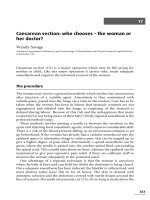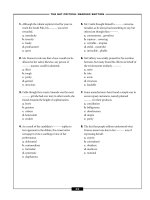Caesarean section - who chooses – the woman or her doctor
Bạn đang xem bản rút gọn của tài liệu. Xem và tải ngay bản đầy đủ của tài liệu tại đây (267.21 KB, 22 trang )
17
Caesarean section: who chooses – the woman or
her doctor?
Wendy Savage
Academic Department of Obstetrics and Gynaecology, St Bartholemew and Royal London Hospital School
of Medicine, UK
Caesarean section (CS) is a major operation which may be life-saving for
mother or child. Like any major operation it carries risks, needs adequate
anaesthesia and requires the informed consent of the woman.
The procedure
The woman may receive a general anaesthetic which renders her unconscious
after injection of a suitable agent. Anaesthesia is then maintained with
volatile gases, passed into the lungs via a tube in the trachea. Care has to be
taken when the woman has been in labour that stomach contents are not
regurgitated and inhaled into the lungs, as emptying of the stomach is
delayed during labour. Because of this risk and the unhappiness that many
women feel at not being aware of their baby’s birth, regional anaesthesia is the
preferred method today.
These methods involve passing a needle in between the vertebrae in the
spine and injecting local anaesthetic agents, which requires considerable skill.
There is a risk of the blood pressure falling, so an intravenous infusion is set
up beforehand. If the woman has already had a catheter introduced into the
epidural space to administer drugs to relieve pain, this can be topped up to
give a higher degree of pain relief. Alternatively a spinal anaesthetic can be
given, where the needle is passed into the cerebro-spinal Xuid surrounding
the spinal cord. This usually lasts about an hour, whereas the epidural can be
maintained to give post-operative pain relief, if there are suYcient staV to
monitor the woman adequately in the postnatal ward.
One advantage of a regional technique is that the woman is conscious
when the baby is born and can hold her whilst the abdomen is being closed.
Once adequate anaesthesia has been induced, the bladder is catheterized, and
most doctors today leave this in for 24 hours. The skin is cleaned with
antiseptic solution and the abdomen covered with sterile drapes around the
line of incision. Normally a horizontal cut 12 to 20 cm long is made above the
263
pubic bone, through the skin, subcutaneous fat and rectus sheath. The rectus
muscles are separated, the peritoneal cavity opened and the uterus comes into
view. This is then opened in the lower part and the membranes ruptured and
the baby delivered though the incision. The cord is cut and the baby passed to
the paediatrician. As the baby has not experienced labour she may be slower
to breathe and Xuid may need to be sucked out of the mouth and nose. The
baby is usually delivered within 10 minutes and then it takes from 20 to 60
minutes to close the abdomen, depending on whether this is a Wrst or later
CS.
Effects and complications of Caesarean section
As with any major operation, the wound is painful and analgesic agents are
required, which may aVect the breast-fed baby. Prophylactic antibiotics are
usually given to prevent infection; thrombolytic agents may be needed to
prevent blood clots forming in the veins and haemorrhage may occur during
or after the operation. Despite the use of prophylactic antibiotics, studies
have shown that 20–45 per cent of women have infection associated with the
operation (Nice et al., 1996). Looking after a newborn baby with a scar in the
abdomen and whilst recovering from surgery is not ideal. Blood transfusion
is needed more often than following a normal birth. Pulmonary embolism is
more common after CS; thus, as the rate of surgery continues to rise (even
though the death rate per 1000 operations has declined over the last 20 years),
the number of women dying following CS has remained much the same in
the UK for the decade to 1993 – 80–90 per triennium (ConWdential Inquiry,
1991–1993 by the Department of Health et al., published in 1997). The direct
eath rate estimated by Marion Hall from the 1988–90 Wgures was 1.8 per
100 000 vaginal deliveries, 14.8/100 000 following elective CS and 25.2/
100 000 following emergency CS (Hall, 1994: p. 191). In the last UK ConW-
dential Inquiry (1994–1996, by the Department of Health et al., published in
1998) the chapter devoted to CS was omitted, ostensibly because of the poor
quality of data about the CS rate. Better case ascertainment makes it diYcult
to compare with earlier inquiries; the overall maternal mortality Wgure rose
from 9.9 in the previous two reports (ConWdential Inquiry 1988–1990,
1991–1993 by the Department of Health et al., published in 1994 and 1997
respectively) to 12.2 per 100 000 maternities in 1994–96 (Department of
Health et al., 1998). I estimate that the rate of death from pulmonary
embolism, which is commoner after any surgical procedure, was nine times
higher following CS than vaginal delivery (4.37 vs. 0.51 per 100 000 delive-
ries) assuming a 15 per cent CS rate during this period. If the CS rate was
lower, the death rate would be at least 10 times higher following CS than a
vaginal delivery.
264 W. Savage
Long-term problems are less well documented, but both voluntary and
involuntary infertility is higher (Hemminki et al., 1985; Jolly et al., 1999).The
risk of CS in a subsequent pregnancy is increased, as is the risk of placenta
praevia (where the afterbirth is in the lower part of the uterus) and placenta
accreta (where the afterbirth penetrates deep in the wall of the uterus). These
are dangerous conditions which may cause massive haemorrhage or even
death if hysterectomy (removal of the uterus) is not performed in time
(Clark, Koonings and Phelan, 1985).
Epidemiology
Over 100 000 CS per year are performed in England, and over a million in the
US. Caesarean section is now the most commonly performed major oper-
ation in the UK. Sixteen per cent of all UK women, and 19 per cent of women
having their Wrst baby in Scotland (which has accurate data), were delivered
by CS in 1995 (Scottish Health Services, 1997). In England, where the data are
less accurate, the overall rate in 1994–95 is also thought to be about 16 per
cent, with some hospitals reaching rates of 25 per cent (Department of Health
Statistical Bulletin, 1997). The English National Board midwifery audit for
1998 (based on replies from 87 per cent of maternal units in England) found
that 68 per cent of units had a rate of 10.0–19.9 per cent, 25 per cent had
20.0–29.9 per cent, and 2 per cent had a rate of over 30 per cent (ENBNMHV,
1998).
The last decade has seen a continuing rise in the rate of CS in most
countries in the world (McIlwaine et al., 1985; Lomas and Enkin, 1989;
Notzon, 1990; Savage, 1990). At the same time that public health physicians
(and some obstetricians) in the western world fear that women are being
subjected to unnecessary surgery, women who need CS are being denied it in
the developing world. Thousands die every week in agony from obstructed
labour or are left with Wstulae that ruin their health and leave them socially
isolated (de Costa, 1998). Even in the West, some women have complained
that when they have asked for a CS, because they feel they are not going to
deliver normally, it has been refused by the doctor, sometimes with disas-
trous consequences. Now in the UK, some obstetricians are saying that
women are asking for CS (Jackson and Irvine, 1998; Mackenzie, 1999)
although the information they have been given before making such a request
is an unknown quantity (McIlwaine et al., 1998). In a later prospective study
Graham et al. (1999) showed that in seven per cent of women having a CS,
maternal preference was a direct factor in making the decision. In the US, the
government set targets to reduce the rate (Department of Health and Human
Services, 1991), which has fallen slightly from its peak of 24.7 per cent in 1989
to 22.8 per cent in 1994 (Clarke and TaVel, 1996).
265Caesarean section: who chooses?
In England in 1990, the government response to the House of Commons
Select Committee report on maternity care (Select Committee Report, 1992;
Department of Health, 1993) aimed to give women more choice and control
over childbirth. These reports emphasized the need for better communica-
tion between professionals and with the woman, and for continuity of care by
fewer people. One had hoped that if 30 per cent of women were looked after
entirely by midwives (as in the Netherlands with a CS rate (CSR) under 10
per cent; TreVers et al., 1990), that this would reduce the CSR, but this has
not happened. This is partly because this target ‘indicator of success’ set by
the Changing Childbirth team has not been met (Rothwell, 1996) and partly
because some obstetricians and midwives have interpreted this directive as
‘allowing’ or giving every woman the right to choose to have a CS (Paterson
Browne and Fisk, 1999).
From the viewpoint of public health, i.e. the health of populations, there
are also problems. The CSR is now 18 per cent; if it should be 10 per cent or
less (World Health Organization, 1985) and if each one per cent rise in CSR
costs the National Health Service £5 000 000 (Audit Commission, 1997), then
unless it can be shown that there is health beneWt from this high cost, there
must be better ways to use £40 000 000.
The rising CSR is not just about medical or woman power, advances in
medical technology or changing societal expectation, it is also about the
organization of services and money. The highest rates are found in countries
in which the medical system is dominated by private practice, as for example
in the US and Australia (Sakala,1993). In South America the even higher rates
are said to be due to social factors, while Chile, with a rate of 37 per cent
nationally, is thought to have the highest rate in the world. The recent steep
rise followed a change in the organization of payment for health care (Murray
and Serani Pradenas, 1997).
A woman’s right to choose a Caesarean section
As a professional, one has a duty to the individual patient, as well as a duty to
society to use resources wisely (General Medical Council, 1995). At the
individual level, one’s advice should be based on good, unbiased, up-to-date
evidence (if it exists), complemented by one’s own experience. Decisions
should be made in the best interests of the patient. The patient has the right to
decline to take one’s advice, but, in my view, does not have the right to ask the
doctor to perform a procedure which the doctor considers unwarranted by
the evidence and which is not in the patient’s best interests. In contrast to
induced abortion, where terminating a pregnancy up to 20 weeks is statisti-
cally safer than carrying a pregnancy to term, in the UK even elective CS
carries a ninefold risk of death compared with vaginal delivery (ConWdential
266 W. Savage
Inquiry, 1994–1996 by the Department of Health et al., published in 1998).
So, whilst as a doctor I can support ‘a woman’s right to choose’ an abortion,
and as a feminist I also support it, I do not think that CS on demand is every
woman’s right. ‘Physicians have the responsibility to inform and counsel
women in this matter. At present, because hard evidence of net beneWt does
not exist, performing CS for non-medical reasons is ethically not justiWed’
(FIGO, 1999).
Those who argue that CS is now so safe that women should be allowed to
choose the mode of delivery quote the risk of damage to the pelvic Xoor and
the risk of a baby dying during labour, but rarely discuss the disadvantages to
the woman of having a major operation, whilst coping with breast-feeding,
sleepless nights and the major life event of becoming a mother. Is death even
mentioned? The overall risk of dying in association with pregnancy is about 1
in 10 000, about the same as one’s risk of dying in a road accident. Following
vaginal delivery it is about 1 in 50 000, and following elective CS it is about 1
in 7000 (Hall, 1994) The risk of a baby dying in labour at term is about 1 in
1000 (CESDI, 1998), and in about half of these cases, with diVerent manage-
ment the baby might have lived. I would prefer to improve the standard of
care so that babies do not die needlessly. Midwifery care has been associated
with good outcomes and low rates of CS – about 1.5 per cent (van Alten,
Eskes and TreVers, 1989; Durand, 1992) – but obstetricians seem reluctant to
look at this work.
The passage of a baby through the birth canal is an amazing process, and
not unnaturally there are changes to the anatomy of the pelvic Xoor. Many
women in middle age have some degree of prolapse of the uterus or vaginal
walls, although with smaller families, and the abandonment of high forceps
deliveries, the number is decreasing. Work done in the 1980s suggested that
damage to the pudendal nerve during childbirth was related to urinary and
faecal incontinence in later life (Snooks and Swash, 1984). Recently the use of
ultrasound to demonstrate damage to the anal sphincter, a promising new
research technique (Sultan et al., 1993), has been used to support the idea of
elective CS to preserve the pelvic Xoor, but rejected in a British Journal of
Obstetricians and Gynaecologists editorial (Sultan and Stanton, 1996). The
high rates reported in this non-random sample do not necessarily Wt with
women’s own perceptions or obstetricians’ clinical observations.
Sleep et al. (1984) reported that two per cent of women (of 67 per cent
followed up in their prospective randomized study of the use of episiotomy)
had urinary stress incontinence three or more times a week, and half of these
used a pad. Occasional stress incontinence was reported by at least a third.
Faecal incontinence was reported occasionally by three per cent of women
three months after delivery but not mentioned in their later follow-up study
(Sleep and Grant, 1987). MacArthur et al. (1997) reported that four per cent
of 916 (out of a total of 1667 women delivered consecutively) developed new
267Caesarean section: who chooses?
faecal incontinence after childbirth, which persisted in 2.4 per cent at 10
months. A more recent study from Scandinavia (Zetterstrom et al., 1999)
found lower rates. Forceps delivery, large babies, occipito-posterior positions
(when the baby’s back is towards the mother’s back and a bigger diameter of
the head passes through the pelvis) and previous constipation have been
associated with higher rates. Third-degree tears, which vary in incidence from
one in 1000 to one in 200 deliveries, are associated with continued faecal
incontinence in up to 50 per cent of women (Tetzschner et al., 1996).
In my experience, women with severe problems with bowel and bladder
control are rarely seen. Planned surgery when the woman is older and not
caring for a newborn baby, for those who are shown to need it, seems a better
use of resources. A review in 1998 concluded that studies on anal and faecal
incontinence ‘are weakened to various degrees by methodological error . . .
There are no good longitudinal data to suggest whether anal incontinence is a
persistent or remitting condition in large populations’ (Bump and Norton,
1998: p. 746).
Why women ask for Caesarean section
Ryding (1993) studied 33 women requesting CS in a Swedish hospital in
1988–90, with a CSR of 8.2 per cent and a perinatal mortality rate of 4.8 per
1000. Half decided to have a vaginal delivery after consultation, giving a rate
of CS on request of 2.7 per 1000, most of these following a diYcult labour the
Wrst time round. Graham et al. (1999) reported the views of 166 women who
had undergone CS; seven per cent of those women expressed a preference for
this mode of delivery.
An editorial in the British Journal of Obstetricians and Gynaecologists in
1996 by a leading urogynaecologist and one of the researchers in the Weld
concluded that it was diYcult to pick out the women who would beneWt from
elective surgery. It would be premature to oVer CS to all women, it was
argued, and the morbidity of this approach would outweigh the beneWts
(Sultan and Stanton, 1996). If all women learned and practised pelvic Xoor
exercises from the teenage years, it would probably provide greater beneWt
and protect against urinary problems in later life (J. Mantle, 1999, pers.
comm.). The evidence about long-term problems following CS is lacking, as
little research has been done in this Weld, so it is diYcult to tell women how
many will suVer from pain in the scar, secondary infertility or pelvic pain due
to infection.
268 W. Savage
Forced Caesarean section: the law in England and Wales
Legal enforcement of the doctor’s decision to perform a CS when the woman
did not consent began in the US in 1973 and became an issue in the 1980s
(Kolder et al., 1987). After 1990, following a successful posthumous appeal
against a forced CS in the case of AC (In re AC, 1990) the climate has changed
in the US. The Wrst reported British case occurred in 1992 (Re S, 1992) and
then in 1996 there followed a spate of Wve cases, two on the same day (Table
17.1).
The Royal College of Obstetricians and Gynaecologists (RCOG) Ethics
Committee published its guidance in 1993 (RCOG, 1993) and stated un-
equivocally that, ‘It is inappropriate, and unlikely to be helpful or necessary,
to invoke judicial intervention to overrule an informed or competent
woman’s refusal of a proposed medical treatment, even though her refusal
might place her life and that of her fetus at risk’. Since then the Court of
Appeal has clearly restated the legal situation in Re MB (February 1997) and
Re S (1998; see Re S, 1996).
English law makes it quite clear that a competent adult has the right to
refuse treatment and that surgery without consent is an assault on the person.
As Wall J said in his judgment in the Tameside and Glossop case (1996):
∑ (i) It remains a criminal and tortious assault to perform physically invasive medical
treatment without the patient’s consent.
∑ (ii) A mentally competent patient has an absolute right to refuse medical treatment
for any reason, rational or irrational, or for no reason at all, even where that
decision will lead to his or her own death.
∑ (iii) Where it is impossible for the patient to communicate the decision through
unconsciousness or lack of mental competence and the treatment is not contrary to
a known competent previously expressed decision of the patient, it is lawful to
provide treatment which is:
(a) necessary to save the life or preserve or prevent deterioration of the physical and
mental health of the patient;
(b) in the patient’s best interests.
∑ (iv) A patient lacks the relevant mental competence to make treatment decisions if
he is incapable of:
(a) comprehending and retaining treatment information;
(b) believing such information;
(c) weighing such information in the balance to make a choice.
The competence test relied on the judgment by Thorpe J in Re C (1994), who
said ‘I consider helpful Dr E’s analysis of the decision-making process into
three stages’ – which are those given above. C was a paranoid schizophrenic
in Broadmoor who did not want his leg amputated. Despite his long-standing
mental illness, he was deemed to have the capacity to make an informed
decision. In fact he recovered the use of his leg with only conservative surgery.
269Caesarean section: who chooses?
The question of competence to decide was modiWed in the MB case, where
the Court of Appeal ruled that a person lacks capacity if some impairment or
disturbance of mental functioning renders the person unable to make a
decision whether to consent to or to refuse treatment. That inability to make
a decision will occur when
(1) The patient is unable to comprehend and retain the information which is
material to the decision, especially as to the likely consequence of having
or not having the treatment in question.
(2) The patient is unable to use the information and weigh it in the balance
as part of the process of arriving at the decision.
If, as Thorpe J observed in Re C (supra), a compulsive disorder or phobia
from which the patient suVers stiXes belief in the information presented to
her, then the decision may not be a true one. SigniWcantly, the question of
belief was dropped, unless it was deemed part of a mental illness.
The Court of Appeal also dealt with the question of ‘temporary factors’
such as confusion, shock, fatigue, pain or drugs, which may erode a person’s
capacity, saying that those concerned must be satisWed that such factors are
operating to such a degree that the ability to decide is absent. Another such
inXuence may be panic induced by fear. Again, careful scrutiny of the
evidence is necessary, because fear of an operation may be a rational reason
for refusal to undergo it. Fear may also, however, paralyse the will and thus
destroy the capacity to make a decision.
It is also clear that in English law the fetus is not a legal entity separate from
its mother, it does not have legal rights. Balcombe LJ expressed this doctrine
in a judgment in the Court of Appeal, In re F (in utero) (1988), where a local
authority sought to make the fetus a Ward of Court and to detain a pregnant
woman, who, despite a history of mental illness and a nomadic life-style, was
not currently suVering from mental illness as deWned by the Mental Health
Act 1983. If the law is to be extended in this country, so as to impose control
over the mother of an unborn child where such control may be necessary for
the beneWt of that child, then under our system of Parliamentary democracy
it is for Parliament to decide whether such controls can be imposed, and if so,
subject to what limitations or conditions.
The Wrst English case where we know that a woman was forced to have a CS
against her will occurred in April, 1992. Caroline Spear was booked for a
home birth, but was transferred to hospital when the midwife found the
presentation to be breech (when the bottom of the baby, not the head is
entering the pelvis, as happens to about three per cent of women at term).
Despite Ms Spear’s objection that breech babies could be born vaginally, the
doctor insisted on performing a CS. Ms Spear allegedly suVered from post-
traumatic stress disorder following the birth, and then sued for assault. The
action was settled out of court for £7000, although the North Middlesex
Hospital did not admit liability. Ms Spear was unable to continue to Wght the
270 W. Savage









